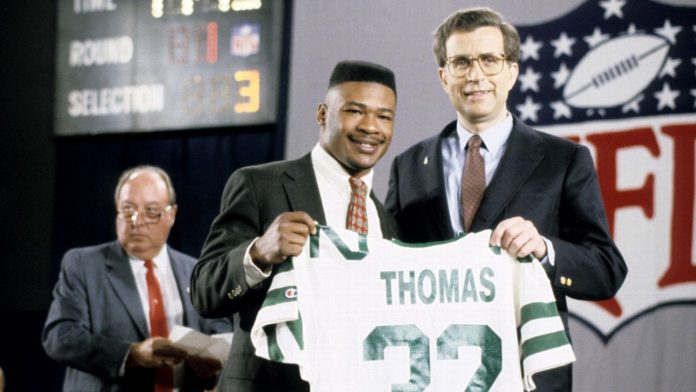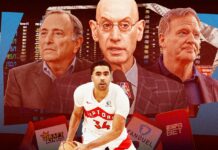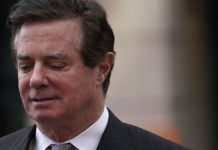FLORHAM PARK, N.J. — They once drafted a defensive tackle who had no cartilage in one knee.
They selected a cornerback who had spent more time in surgery than The Good Doctor.
They picked a tight end who never caught more than 27 passes in a college season and a wide receiver/track star who had played in a wishbone offense.
And they were all chosen in the top 10.
The New York Jets have an inglorious history of top-10 picks, an array of head-scratchers and faux blue-chippers who never reached expectations and faded into the great green ether. Even some of the so-called good picks, applauded by fans and pundits, washed out.
They should be better, considering they’ve had a lot of practice.
In the common-draft era, which began in 1967, the Jets have picked 26 players in the top 10, tied with the Detroit Lions for the third-most, according to ESPN Stats & Information research. The Arizona Cardinals and Cincinnati Bengals have 28 apiece.
Barring trades, the Jets will move into a three-way tie for first on April 28. They own the fourth and 10th picks in the draft, the latter acquired from the Seattle Seahawks in a trade for safety Jamal Adams in 2020. It’s their first time in franchise history with two top-10 picks.
To date, their 26 picks have produced only one player with multiple All-Pro seasons (tackle Marvin Powell) and only one Pro Football Hall of Famer (running back John Riggins), whose best years were post-Jets. If you’re wondering about Joe Namath, a Hall of Fame quarterback, he was drafted in 1965, when the NFL and AFL held separate drafts.
You think it would be hard to screw it up, but it happens.
“It’s been a run of bad luck,” ESPN draft analyst Jordan Reid said. “They’ve had some good ones here lately. I think [quarterback] Zach [Wilson] is going to be fine. [Defensive tackle] Quinnen [Williams] is coming along; he just has to stay healthy. It’s getting better, but there was a rough stretch there. I remember some of those guys. It was just a string of bad luck.”
In theory, the Jets should get two future stars at Nos. 4 and 10, but we all know the draft doesn’t work like that. A look back at the Jets’ top 10s, from Riggins (1971) to Wilson (2021):
Biggest busts: Cornerback Dee Milliner (2013) and edge rusher Vernon Gholston (2008) stand above the crowd — or below, depending on how you look at it.
Gholston, in three NFL seasons, failed to record a single sack. In the 2010 season finale, a game that meant nothing because the Jets had clinched a playoff spot, the coaches designed specific plays for Gholston so he could get that elusive sack. Not even a customized game plan worked.
Milliner was highly regarded for his cover skills, but there was some concern because he underwent surgery five times at Alabama. In his first training camp, sure enough, he got hurt. By 25, his career was over. No 2013 first-round pick played fewer games than Milliner (21).
Loudest boos on draft day: With the New York crowd chanting “We want Sapp!” in 1995, the Jets stunned everyone by drafting tight end Kyle Brady, who was greeted on stage with a chorus of boos. They passed on defensive tackle Warren Sapp, who would go on to a Hall of Fame career. At the time, the Jets felt Sapp was too risky because of off-the-field issues.
“I admit, I was as mystified as the fans were,” Brady told ESPN seven years ago in a story about his draft-day experience.
Brady, who had only modest receiving numbers at Penn State, played 13 years and made about $30 million. A nice career, to be sure, but no gold jacket.
Reckless climbing: The Jets made three huge trades to get into the top 10, two of which turned out to be big mistakes. In 1980, they jumped up for wide receiver Johnny “Lam” Jones, an Olympic sprint champion who developed a chronic case of the yips. They had been targeting tackle Anthony Munoz, but pivoted because of concerns about his surgically repaired knee. That didn’t prevent him from becoming a Hall of Famer with the Bengals.
In 2003, the Jets made a similarly bold move to get defensive tackle Dewayne Robertson. They ignored a potential knee problem (look, no cartilage!) because they felt he was good enough to be Sapp 2.0. Not even close.
The third trade, in 2009, was for quarterback Mark Sanchez, who won four playoff games (all on the road) before his career petered out. Unlike the previous two trades, this one didn’t cost them two first-round picks. They thought they had their franchise quarterback … until they didn’t.
Sneaky good picks: Powell (1977) never gets mentioned among the Jets’ greats, but he deserves to be included in that conversation with three first-team All-Pro selections on his resume.
“I wouldn’t have been the player I was without Marvin Powell,” legendary Jets pass-rusher Mark Gastineau said. “We made each other better every day in practice.”
Another sneaky good pick was tackle D’Brickashaw Ferguson (2006), who didn’t miss a game or practice in 10 years. He was their Cal Ripken Jr.
First team All-Pro: One-time recipients of the honor were Adams (2017), linebacker James Farrior (1997), wide receiver Al Toon (1985) and running backs Riggins and Freeman McNeil (1981). Farrior and Riggins, it should be noted, achieved the recognition with the Pittsburgh Steelers and Washington, respectively. Toon’s promising career was cut short by concussions, one of the saddest chapters in Jets history.
One gold jacket: Riggins, known as a wild child of the ’70s, was an immediate star for the Jets. He was a Pro Bowl player and the team MVP in 1975, but a contract dispute led to his release and he signed with Washington. If you want to track the Jets’ history of giving up on good players, start here.
Most popular school: They picked enough players from USC to start a Trojans’ alumni club — six. Aside from Powell and Sanchez, there was quarterback Sam Darnold (2018), defensive end Leonard Williams (2015), wide receiver Keyshawn Johnson (1996) and tackle Dave Cadigan (1988), whose career got off to a rough start. In his first game, he got run over by New England Patriots star Andre Tippett, who may have left cleat marks on Cadigan’s chest. Later in his career, the former Trojan made headlines for threatening a reporter in the locker room. Fight on, indeed!
The ‘what-if’ draft: In 1990, the late Dick Steinberg fell in love with running back Blair Thomas. After watching Thomas win MVP in the Senior Bowl, the GM told a reporter that day in Mobile, Alabama, “Even my grandmother could tell you he was the best player on the field.” Important note: Linebacker Junior Seau and defensive tackle Cortez Kennedy, both juniors, were not on the field.
Thomas, drafted second overall, never panned out. The next two names on Steinberg’s draftboard, Seau and Kennedy, went on to Hall of Fame careers with the San Diego Chargers and Seahawks, respectively. Grandma should’ve scouted the underclassmen.
All-longevity team: Most games played by a top-10 pick — Farrior 230, Brady 197 and Riggins 175. All three played more games with other teams than the Jets.
Busiest GM: Mike Maccagnan lived in the top 10 — four picks in five drafts as the Jets’ GM. Yeah, they did a lot of losing to get in those positions. He had his share of draft misses, but his tops picks weren’t all that bad. Defensive tackle Quinnen Williams (2019), Adams and Leonard Williams are productive players in the league, with Darnold the lone question mark.
The Jets were ecstatic to get Darnold. When he unexpectedly fell to No. 3, a team official in the giddy draft room turned to Maccagnan and said, “You have a horseshoe up your ass.”
Eventually, the good fortune was washed away by reality — a familiar theme.
Source : ESPN














